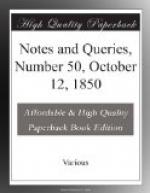That she was not the daughter of either Henry II., Henry III., or Henry IV., is very certain; in the first case, for the reason stated by your correspondent; and in the second, because Henry III. was only twelve years old when he succeeded his father Conrad II. (in the year 1039), which of course puts his son Henry IV. quite out of the question, who was born A.D. 1049. It strikes me (and perhaps some of your correspondents will correct me if I am wrong) that the two English princes may have respectively married the two ladies to whom I have referred, and that hence may have arisen the discrepancies in the different histories: but that the wife of Edward the Outlaw was one of these two I have no doubt.
O.P.Q.
Translations of the Scriptures (Vol. ii., p. 229.).—C.F.S. may perhaps find The Bible of every Land, now publishing by Messrs. Bagster, serviceable in his inquiries respecting Roman Catholic translations of the Scriptures. The saying of the Duke of Lancaster is found in the first edition of Foxe’s Acts and Monuments, and in the modern reprint, iv. 674.; the original of the treatise from which it is taken being in C.C. College, Cambridge. (See Nasmith’s Catalogue, p. 333.)
NOVUS.
Scalping (Vol. ii., p. 220.).—W.B.D. confounds beheading with scalping. In the American war many British soldiers, it was said, walked about without their scalps, but not without their heads.
SANDVICENSIS.
* * * * *
MISCELLANEOUS.
NOTES ON BOOKS, SALES, CATALOGUES, ETC.
No one branch of antiquarian study has been pursued with greater success during the last few years than that of Gothic Architecture; and, to this success, no single work has contributed in any proportion equal to that of the Glossary of Terms used in Grecian, Roman, Italian, and Gothic Architecture. Since the year 1836, in which this work first appeared, no fewer than four large editions, each an improvement upon its predecessor, have been called for and exhausted. The fifth edition is now before us; and, we have no doubt, will meet, as it deserves, the same extended patronage and success. When we announce that in this fifth edition the text has been considerably augmented by the enlargement of many of the old articles, as well as by the addition of many new ones, among which Professor Willis has embodied a great part of his Architectural Nomenclature of the Middle Ages; that the number of woodcuts has been increased from eleven hundred to seventeen hundred; and lastly, that the Index has been rendered far more complete, by including in it the names of places mentioned, and the foreign synonyms; we have done more to show its increased value than any mere words of commendation would express. While the only omission that has been made, namely, that of the utensils and ornaments of the Mediaeval Church (with the exception of the




